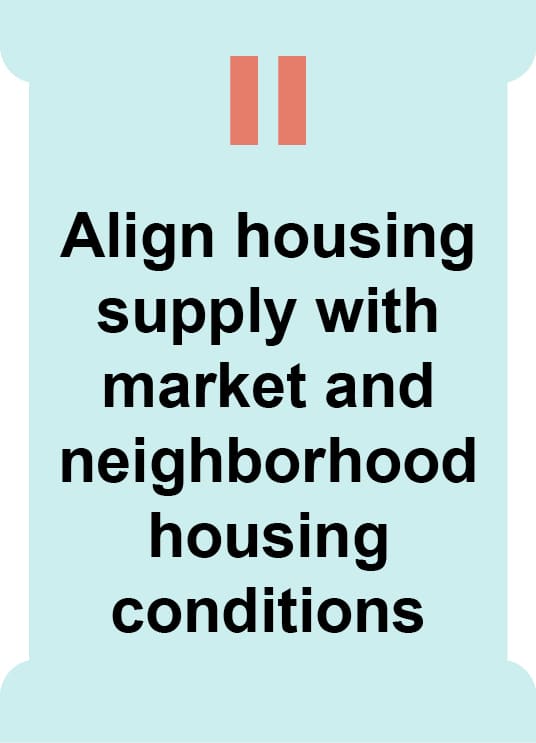3.2 Pillar II
Pillar II - Align Housing Supply With Market and Neighborhood Housing Conditions
While it’s essential to create and preserve dedicated affordable housing units (Pillar I), that approach will rarely be enough on its own to fully address a locality’s housing challenges. Research shows that the ability of the broader housing market to respond to demand for a variety of housing products is essential to constraining rising housing prices. There are many barriers to the market’s ability to create the overall supply of housing needed, which localities can address through housing policy. To promote affordability, cities, towns, and counties should adopt a balanced approach that supports both creating and preserving dedicated affordable housing and removing barriers to new development for all income levels.
Watch this video on increasing overall supply to improve affordability.
Pillar II, Align Housing Supply with Market and Neighborhood Housing Conditions, is the second half of that equation. It also includes policies applicable to localities with slow or declining housing markets.

Policy Subcategories Under Pillar II:
- Planning
- Reducing development costs and barriers
- Creating incentives for new development
- Dealing with vacant, abandoned, and tax-delinquent properties
1. Planning
This subcategory is unusual in including only one policy, which is listed below. This policy focuses on understanding neighborhood conditions well enough to develop a tailored approach to aligning housing supply with neighborhood conditions:
Neighborhood conditions often vary across a municipality. In order to tailor the locality’s approach under this Pillar, it’s important to collect and analyze data on area conditions and gather input from residents to understand the underlying factors behind what the data illustrate. For example, high housing costs and constrained land availability in one neighborhood may suggest that it would be helpful to rezone to allow for higher-density development, while a large number of vacant or abandoned properties in another neighborhood may suggest the need for a very different set of policies aimed at addressing blighted conditions. Neighborhood-level planning can be helpful in all housing markets but is especially important in localities with neighborhoods with a mix of housing conditions. For more information on neighborhood variation to inform a local housing strategy, read this brief.
2. Reducing development costs and barriers
As the video describes, a limited supply of housing geared to middle- or higher-income households can affect the affordability of housing for low- and moderate-income households as well. Here’s how it works:

How does an insufficient supply of housing lead to affordability challenges?
Click on each of the questions below to learn what localities can do to interrupt this adverse chain reaction.
Outdated land use regulations can restrict developers’ ability to create enough housing supply, causing higher housing prices through the chain reaction noted above. They can also create residential segregation, preventing lower-income households from moving into higher-income neighborhoods because of housing supply constraints, which impede residents’ across-city mobility and further exacerbate areas’ economic differences.
To reduce barriers to housing development, localities can update regulations that restrict housing supply (for example, by increasing permissible density) and establish a clear, predictable development process that minimizes the need to seek special approvals or permits. Uncertainty associated with approval processes can slow down development timelines and prevent projects from happening.
To learn more about a sample of policies within this subcategory, Reducing development costs and barriers, match up the examples below with the correct definition by first clicking on a policy and then clicking on the box where you think it should go. Do this for each of the policies, and then check your results.
3. Creating incentives for new development
Policies in this subcategory provide financial incentives or other financial support for housing development in specific locations or of a specific type without attached rent or income restrictions. This differs from the incentives subcategory in Pillar I, which focuses on incentivizing the creation or preservation of dedicated affordable housing.
To learn more about a sample of policies within this subcategory, match up the examples below with the correct definition by first clicking on a policy and then clicking on the box where you think it should go. Do this for each of the policies, and then check your results.